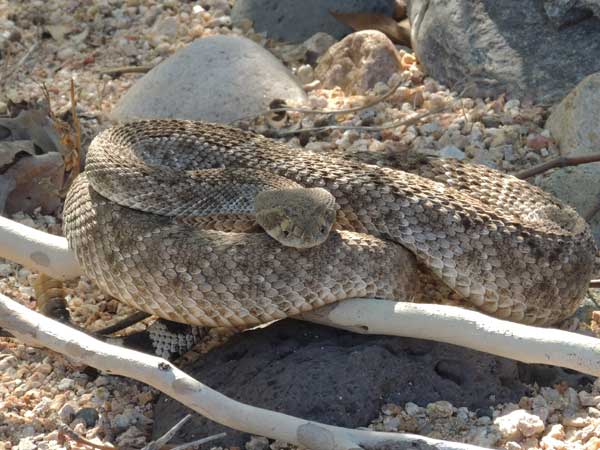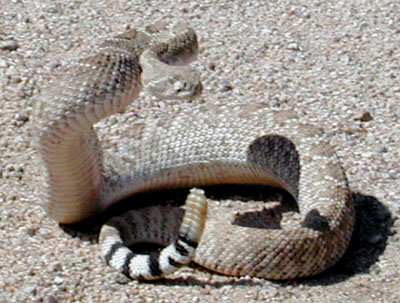Western Diamondback Rattlesnake
Crotalus atrox

Near Mesquite Wash, Maricopa Co., Arizona. 6 Oct. 2016.
Sponsored Links:
This large rattlesnake ranges from far southeastern California through to Texas and south into northern Mexico. Although not as venomous as the Mojave Rattlesnake, this animal demands respect from hikers and naturalists. It tends to occur in rockier or more heavily vegetated habitat so that bushwhacking hikers must be careful with hands and feet. Luckily these snakes are often quick to warn if approached too closely. The loud rattle is startling, but should be met with calm until the snake's location can be verified. The snake's first instinct is to retreat and its route should be unimpeded. Hikers should not molest or harm these important predators of rodents and other small mammals. The black and white bands of the tail tend to be subequal in width.
While searching areas near Mesquite Wash for interesting plants, AZNPS field trip participants discovered a pair of western diamondbacks just as they were beginning a mating encounter. The female had already entered a very quiet, nearly trance-like state. This female did not respond even with too-close approach and the male's movements confused us until we realized we were interfering with biology's most vital directive. Once we stepped out of the arena the process continued as documented in this video:
Viperidae -- Viper Family
More Information:
Mojave or Diamondback Rattlesnake?
Crotalus sp.

Photo taken hear Hillside, Arizona as a group of 7 naturalists admired its aggressive stance while encouraging it to move off of the roadway for its own safety. It was about 2/3 of a meter in length, and appeared to be carrying a recent meal within its abdomen. The rattle sound was loud and convincing.
Sponsored Links:
My first impression of this snake was Western Diamondback (Crotalus atrox). However, it was pointed out to me by Jorge, a snake specialist and visitor to this page, that in this specimen the white bands on the tail are wider than the black, a characteristic of the Mojave. Also it appears that the pale diagonal line from just behind the eye, reaches a point posterior to the corner of the mouth. The most definitive characteristic separating the Mojave from the Western Diamondback are a pair of large scales between the supraoculars on the snout. I zoomed in on the snout area with my image program, but the resolution was insufficient to see individual scales. Next time I will have to get a little closer yet, before I snap the shutter release!
On the other hand, Val Buckner offered the following analysis:
Having collected numerous Mojaves from the east Mojave area, where they have a consistently green background coloration (although none personally from the Arizona area, where it seems color and pattern can vary quite a bit) I'm going to have to dispute the ID and say the snake pictured is an atrox due to the extreme contrast between the tail bands (stark white & jet black) which is extremely rare in the Mojave but definitive of the Atrox, although as mentioned, the band spacing is similar to the Mojave. The Mojave's tail band(s) do not generally encircle the tail as the Atrox's do and as the terminus band(s) appear to do in the photo. The head also appears to be rather large in relation to body length and girth which is an atrox trait, whereas the Mojaves tend to have a smaller, narrower head compared to most of the Crotalus species. A hybrid possibly.
The Mojave Rattlesnake besides inhabiting the Mojave Desert also is common in the Sonoran And Chihuahuan Deserts. Creosote flats are a frequent habitat where they hunt almost exclusively at night.